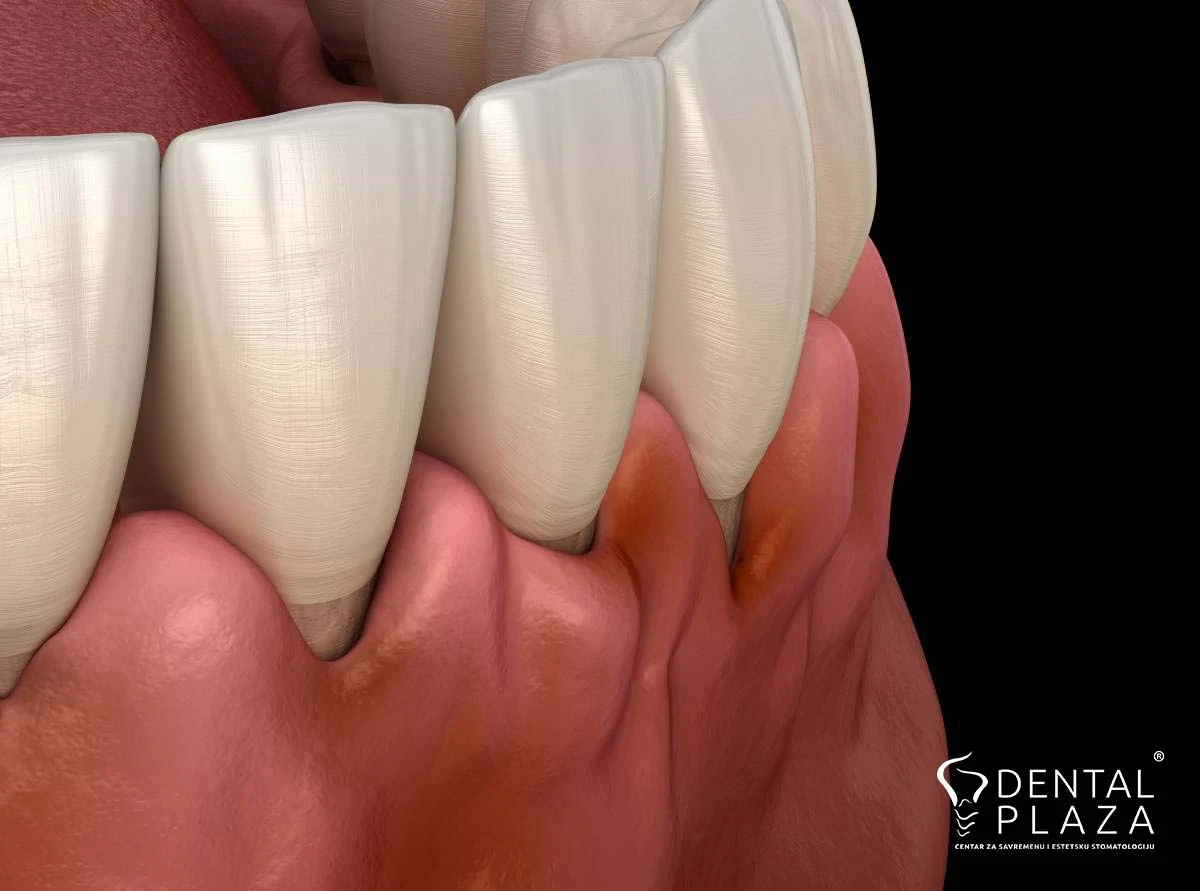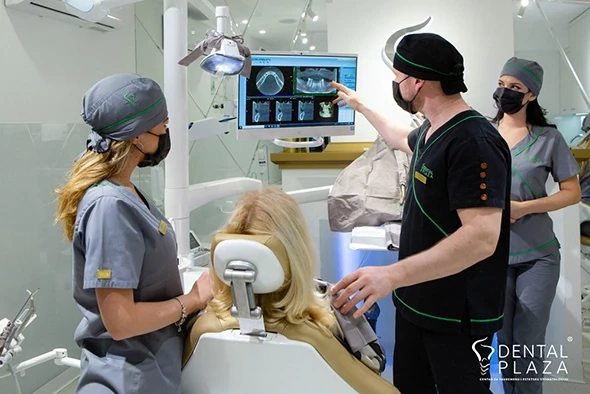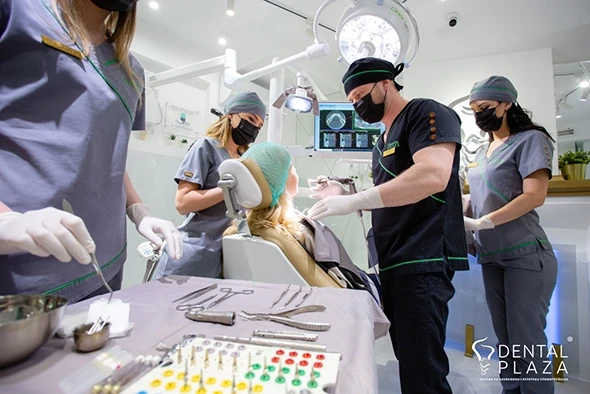Do not be shy, show your teeth!
Call Center 08-21h
Do not be shy, show your teeth!
Call Center 08-21h

Soft tissue management includes the processes by which soft tissues are formed, shaped and prepared for future fixed prosthetic work. When it comes to implant placement, it is oftenly recommended the implants to be surrounded by “solid” (adherent / keratinized) soft tissue, instead of “mobile” gum tissue, in order to improve their long-term prognosis, and this is achieved through several different procedures.
The presence of firm and keratinized gingiva in the region around the implant increases the longevity and health of all tissues surrounding the implant.
This process, among other things, involves the construction of a temporary bridge based on a wax model, as a starting point for planning the prosthetic part of the therapy. This adjusts the shape of the gums to future prosthetic work. Also, various surgical methods can improve the condition of soft tissue and, as part of these therapeutic procedures, transplants from the palate can be used, or artificial preparations that are then transplanted to the region around the tooth or implant where it is necessary. In these cases, connective tissue transplants (TVT) or SMAT can be used to cover the exposed area.
Conversely, a lack of adherent solid gingival tissue around the implant more often leads to periimplantitis, gum retraction (gingival recession) and may lead to greater accumulation of dental plaque.
Modern surgical procedures used in periodontal surgery include the use of autotransplants of connective tissue or artificial grafts along biomembranes. These procedures are performed under local anesthesia and recovery after them is not difficult for the patient.
The soft tissue management process also involves wearing a sulcus formers when the implant placement is completed. These are caps that are put on as standard to enable adequate gum healing. In the period after implant placement, until the final prosthetic work is done, an abutment can be placed on the implant (the part of the implant that is visible in the oral cavity is screwed to the implant and is a counterpart to the polished crown of a natural tooth).

It requires several visits with an interval of one week, and that prolongs the time from "opening the implant" until taking an impression for a definite upgrade. During that time, the patient is taken care of with a temporary crown, which is modeled from a composite on a temporary abutment. This shapes the gingival exit profile around the implant so that future crowns look aesthetically perfect, and you can be assured that this is exactly what they will be like with the Dental Plaza team of experts.
With these procedures, the gums get a shape and form that perfectly fits the future crowns and gives high quality aesthetic results. Also, healthy and firm gingival tissue around the crowns will enable easier maintenance of oral hygiene and thus increase the longevity of the prosthetic work itself. In the region of the implant, keratinized adherent gingiva will prevent the loss of marginal alveolar bone and reduce the possibility of periimplantitis.

If the procedure involves any of the above surgical procedures, then everything must be performed under local anesthesia and is completely painless and comfortable for the patient. Sometimes these procedures require more visits to the dentist. After periodontal surgery, the discomfort should be minimal.
Postoperative pain and swelling are insignificant for a few days after the intervention. With the instructions of the dentist, you can take painkillers and possibly antibiotics during that period. There may be a slight swelling and in that case we recommend the use of cold compresses.
During the period from 5 to 7 days after the procedure, your diet should be limited to soft foods and in that period you should avoid significant physical activity. It is important that while performing these therapeutic procedures, you maintain adequate oral hygiene and listen to the advices of your dentist. The Dental Plaza team is there to always provide its patients with all the appropriate informations and instructions when it comes to maintaining oral hygiene.

Do you have questions?

Soft tissue management includes the processes by which soft tissues are formed, shaped and prepared for future fixed prosthetic work. When it comes to implant placement, it is oftenly recommended the implants to be surrounded by “solid” (adherent / keratinized) soft tissue, instead of “mobile” gum tissue, in order to improve their long-term prognosis, and this is achieved through several different procedures.
The presence of firm and keratinized gingiva in the region around the implant increases the longevity and health of all tissues surrounding the implant.
This process, among other things, involves the construction of a temporary bridge based on a wax model, as a starting point for planning the prosthetic part of the therapy. This adjusts the shape of the gums to future prosthetic work. Also, various surgical methods can improve the condition of soft tissue and, as part of these therapeutic procedures, transplants from the palate can be used, or artificial preparations that are then transplanted to the region around the tooth or implant where it is necessary. In these cases, connective tissue transplants (TVT) or SMAT can be used to cover the exposed area.
Conversely, a lack of adherent solid gingival tissue around the implant more often leads to periimplantitis, gum retraction (gingival recession) and may lead to greater accumulation of dental plaque.
Modern surgical procedures used in periodontal surgery include the use of autotransplants of connective tissue or artificial grafts along biomembranes. These procedures are performed under local anesthesia and recovery after them is not difficult for the patient.
The soft tissue management process also involves wearing a sulcus formers when the implant placement is completed. These are caps that are put on as standard to enable adequate gum healing. In the period after implant placement, until the final prosthetic work is done, an abutment can be placed on the implant (the part of the implant that is visible in the oral cavity is screwed to the implant and is a counterpart to the polished crown of a natural tooth).

It requires several visits with an interval of one week, and that prolongs the time from "opening the implant" until taking an impression for a definite upgrade. During that time, the patient is taken care of with a temporary crown, which is modeled from a composite on a temporary abutment. This shapes the gingival exit profile around the implant so that future crowns look aesthetically perfect, and you can be assured that this is exactly what they will be like with the Dental Plaza team of experts.
With these procedures, the gums get a shape and form that perfectly fits the future crowns and gives high quality aesthetic results. Also, healthy and firm gingival tissue around the crowns will enable easier maintenance of oral hygiene and thus increase the longevity of the prosthetic work itself. In the region of the implant, keratinized adherent gingiva will prevent the loss of marginal alveolar bone and reduce the possibility of periimplantitis.

If the procedure involves any of the above surgical procedures, then everything must be performed under local anesthesia and is completely painless and comfortable for the patient. Sometimes these procedures require more visits to the dentist. After periodontal surgery, the discomfort should be minimal.
Postoperative pain and swelling are insignificant for a few days after the intervention. With the instructions of the dentist, you can take painkillers and possibly antibiotics during that period. There may be a slight swelling and in that case we recommend the use of cold compresses.
During the period from 5 to 7 days after the procedure, your diet should be limited to soft foods and in that period you should avoid significant physical activity. It is important that while performing these therapeutic procedures, you maintain adequate oral hygiene and listen to the advices of your dentist. The Dental Plaza team is there to always provide its patients with all the appropriate informations and instructions when it comes to maintaining oral hygiene.
